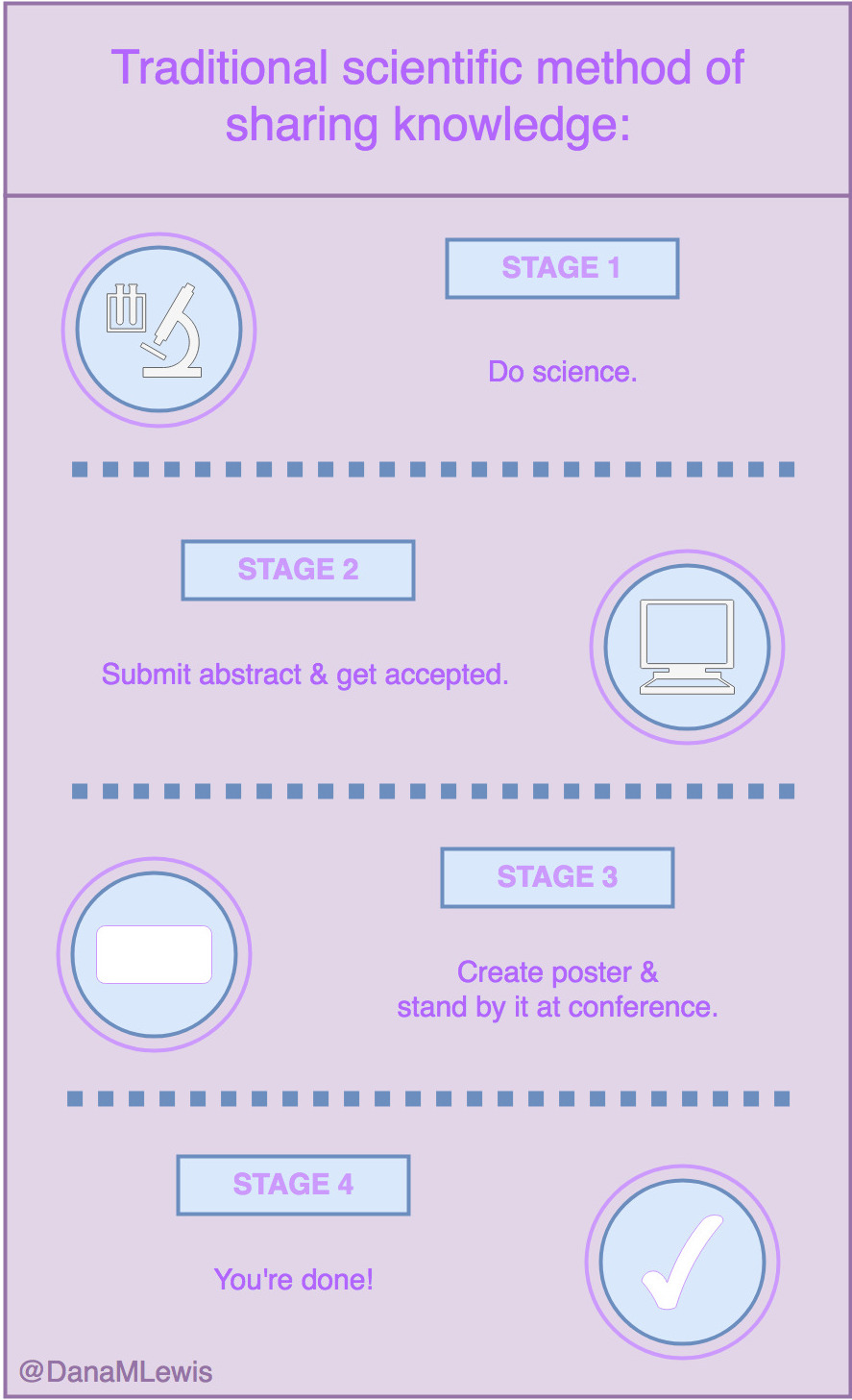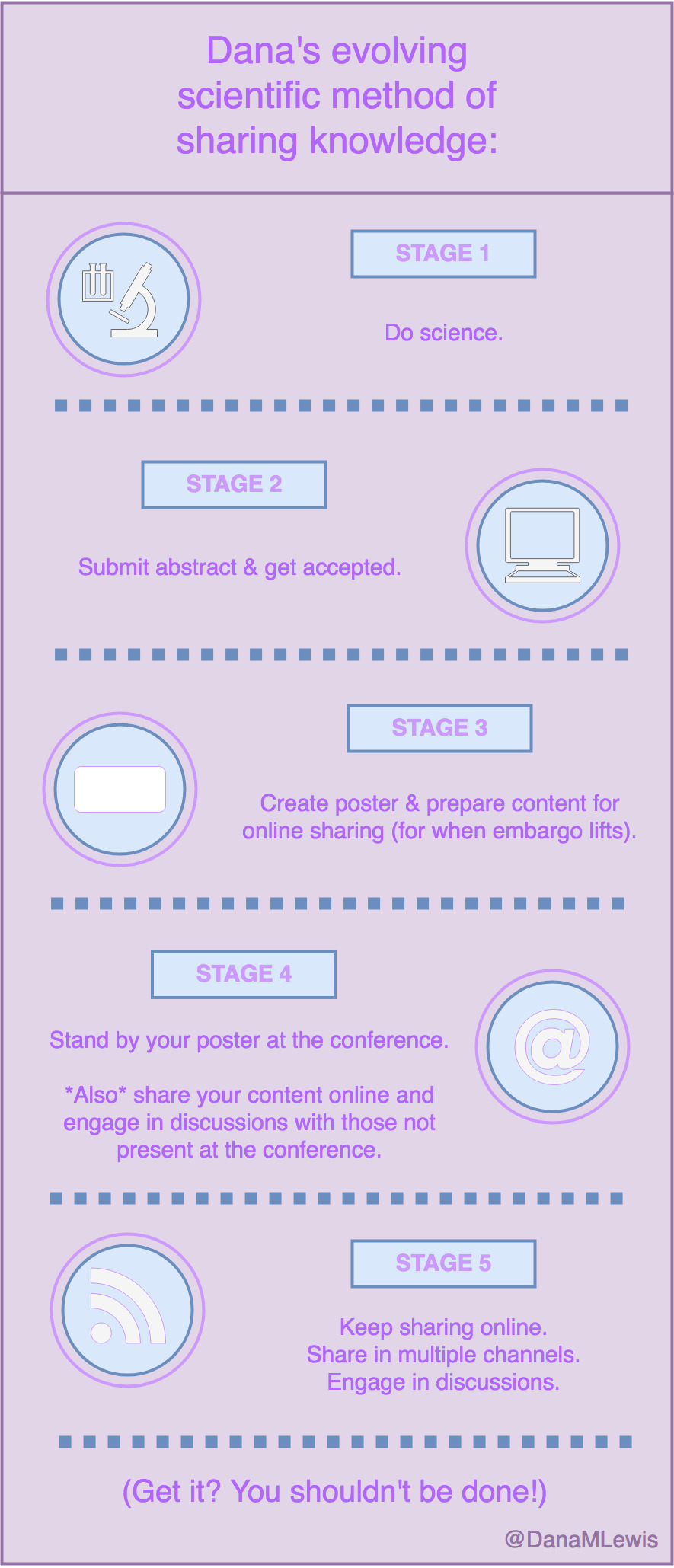Spreading scientific knowledge
In the past week, I returned from presenting some of our team’s data science work and some of my other non-Opening Pathways work at the American Diabetes Association’s 78th Scientific Sessions. I started describing to the rest of the Opening Pathways team some of the work I had done to package, prepare, and share our work both during and after the conference.
As a result of that conversation, they suggested it would be useful to capture some of the tips I was providing them about ideas to spread scientific work beyond the conference. I agreed, with the caveat that this is not a perfect, comprehensive, or exhaustive list. Instead, this is a walkthrough of the approach I take and some of the things I considered. As with all communication strategies, it depends greatly on your goals and audience(s). Keep in mind, there’s lots of great #scicomm (great hashtag on Twitter) advice and suggestions out there; feel free to share some of your favorite ideas and tips in the comments with us!
The observed scientific method of sharing scientific knowledge
When I presented a poster at my first scientific conference, the advice I got was pretty much this:

Even though I had major imposter syndrome going on, I felt uncomfortable with that being “all”. Especially because I was aware that my audience wasn’t just the people who were at the conference - I also wanted to reach health care providers (HCPs) and people with diabetes around the world who weren’t at the conference. And so, in 2016, after the embargo lifted (this particular conference requires that you wait until a certain date/time before sharing any content from the conference), I posted a blog post with our entire poster’s contents so it was immediately and fully accessible to anyone interested in reading about our work.
It worked really well - the community had access to the content; HCPs could read it and easily share it; and we could point to it online in the future. And it wasn’t paywalled. Even though a journal later asked me to write a letter to the editor (LTE) summarizing our work, I pointed out that this LTE would essentially be a similar version to the already available blog content and thus we couldn’t assign copyright. However, the journal was great about working with us to modify the intellectual property transfer form to acknowledge this fact, and we were therefore still able to publish a version of our research in the “traditional peer-reviewed” literature.
Lessons learned from that first year: posting full poster content online is good, and doesn’t limit our ability to traditionally publish our work, either.
But in the last two years, I wanted to do even more to share our content, encourage conversation, and further engagement around our work (and to ideally facilitate more people to work in this space!). I especially wanted all of this to live on beyond the few days of the scientific conferences.
Dana’s evolving scientific method of sharing scientific knowledge:
There are different ways to accomplish this, but this was my formula with #2018ADA for poster and oral/symposium presentations:

Poster:
- Develop poster content (review and revise for readability)
- Convert or write a version for posting online in blog format
- Take a picture when you hang your poster, to add to the blog post
- Convert to a Twitter thread (threaded, linked tweets of key points)
When the embargo lifts: post your blog post; add the link of the blog post in the first tweet of your Twitter thread along with a picture of your poster; post your Twitter thread (see example)!
Oral or Symposium Presentation:
- Develop visual slides
- Font should be large and readable from the back of large rooms
- Use visuals rather than blocks of text wherever possible to make your key points
- Write a bullet point version of your talk in tweet-form
- Grab screenshots of key slides or data results to include in the tweet thread
- It’s helpful to check your length of sentence with Twitter as you go (remember Twitter now allows for 280 characters per tweet)
- Then connect the dots and convert it into a blog post version
After the presentation: post the blog; and add that link to the top of the thread; then tweet the thread out (see example)!
Other tips:
- You should include a slide at the front of the presentation to explicitly state if photography is encouraged - this is also a good opportunity to remind people of your Twitter handle and the conference hashtag, which helps increase the likelihood that they’ll tag you by name in any tweets about your presentation.
- Of course, you’ll also want to include your Twitter handle & conference hashtag at the footer of every slide, too.
- If you’d like an example, there’s a free template I’ve created that’s licensed to be used by anyone/for anything available here. It shows the encouraging photography slide and also the icons for the footer of the slide.
- To encourage sharing, make sure to include a green camera icon (or a green camera icon and a green checkmark like I did) on every slide. You can also put that icon on your posters!
- Use bit.ly links (or a similar link shortener with analytics, see here if you are unfamiliar) to get a glimpse at how much people are looking at your content.
- You can use other things like Google Analytics, but if you don’t have the time, just glancing at bit.ly a few days later (put it on your calendar) gives you a good feedback mechanism to understand if your content is being looked at, and how much relative to other things you sahre.
- You can also create custom URLs to make it easy for people to see what they’re clicking on in social media.
- For example:
- https://diyps.org/2018/06/23/presentations-and-poster-content-from-danamlewis-at-2018ada/ became http://bit.ly/DanaMLewis2018ADA
- https://openaps.org/2018/06/23/detecting-insulin-sensitivity-changes-for-individuals-with-type-1-diabetes-with-autosensitivity-from-openaps-poster-presented-at-american-diabetes-association-scientific-sessions-2018ada/ became http://bit.ly/2018ADAautosensitivityposter
- For example:
If you’d like to see examples:
- My tweet thread for my poster; my symposium presentation; and my oral presentation.
- My blog post, where I posted the long-form versions of that content
- (Note: you may want to do separate blog posts for the long-form versions of your content; mine happen to be related and I chose to put them on the same page, but in previous years I had separated content and found that also worked well.)
My final tip/suggestion, in parallel to acknowledging that this is a lot of work: make sure to discuss this work with any colleagues/team and include this in the list of tasks that you divide and conquer for preparing for conferences. Make sure you’re on the same page about where content is posted (and when, to respect the embargos if applicable), and make sure your team is tagged in any content so they have a nice reminder to help share it, too - even if they aren’t physically present at the conference.
Does doing some of this “extra” communication take more work than simply giving a presentation or posting your poster and walking away? Yes. But does it significantly expand the reach of your scientific work; encourage others to share your work and engage in discussions; and draw in new audiences to the work? Also yes!
Share
Twitter Facebook Google+ LinkedInLeave a Comment
Your email address will not be published. Required fields are marked *

Comments
Dana M. Lewis